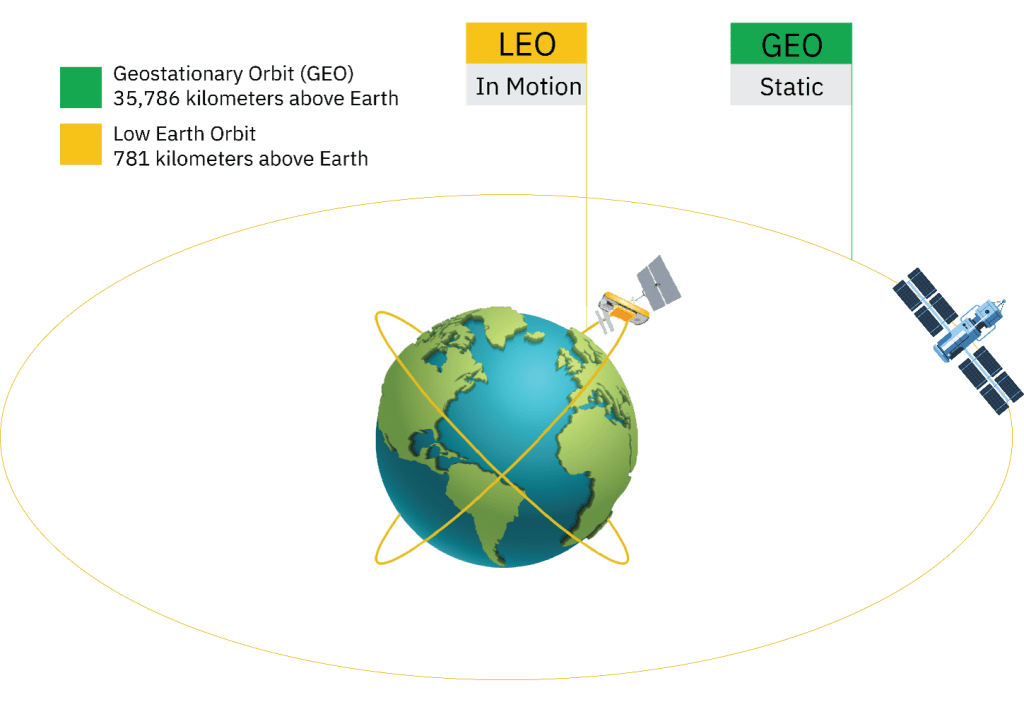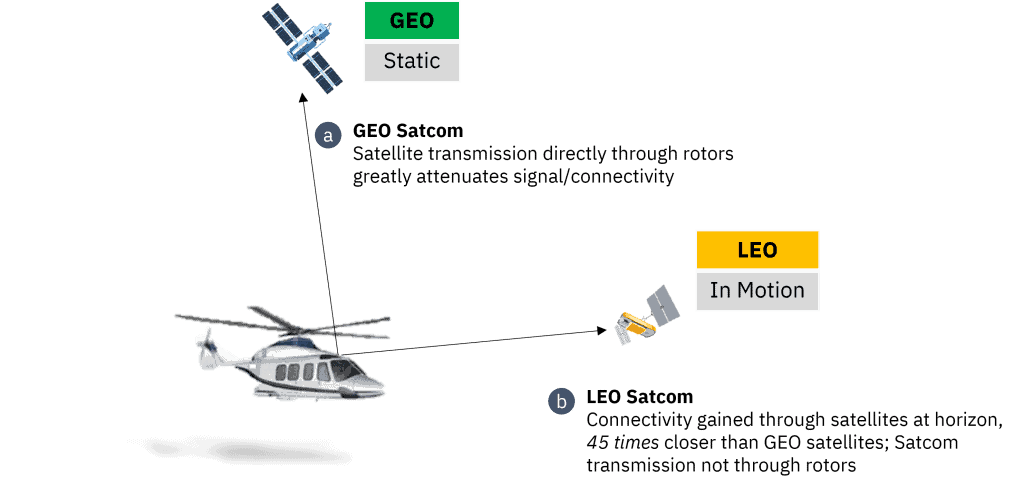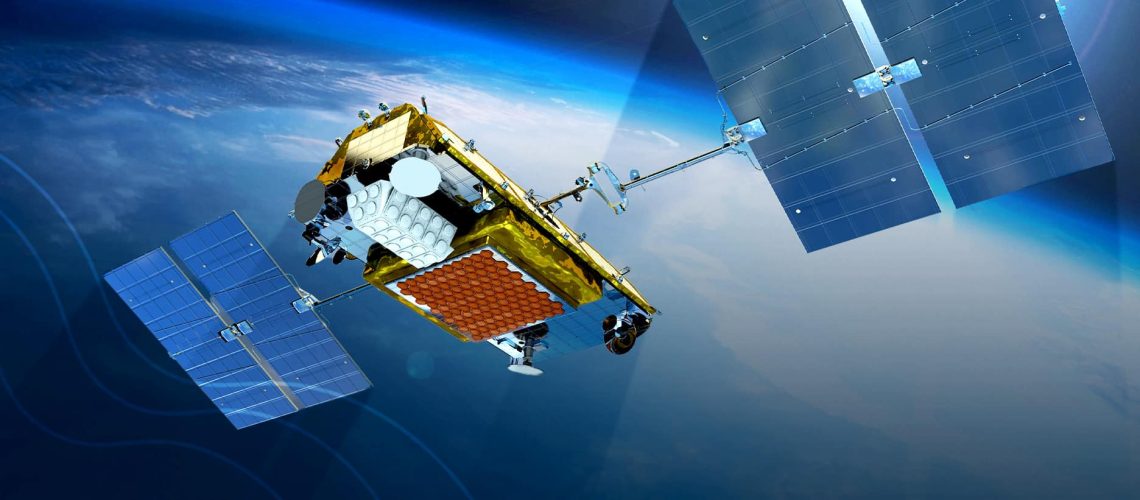In the last article in SKYTRAC’s #SatcomSeries, we briefly touched on some of the capabilities that Lower Earth Orbit (LEO) and Geosynchronous Equatorial Orbit (GEO) provide for the aviation industry. LEO and GEO satellites serve different roles for aviation and choosing the right network will depend on the requirements of the aircraft and what missions are being served. In this article, we dive into the differences between LEO and GEO satellites, what their strengths are, and their limitations to help you make an informed choice.
Table of Contents
What is a Geosynchronous Equatorial Orbit (GEO) Satellite Network?
GEO satellites are positioned at roughly 36,000 km above the Earth’s equator and rotate in the same direction and speed as the Earth. This fixed positioning ensures that satellite transmission remains consistent and focused on a particular region on the planet. These GEO networks can provide a wide range of coverage to approximately 80% of the planet, limited due to the curvature of the Earth. Due to the distance from the planet, GEO satellites require a high-power directional antenna that must continually be aligned towards the satellite, which may pose a challenge for assets in continual motion. These antennas are typically large, expensive, and have many moving parts requiring maintenance and upkeep.
Strengths of GEO Satellites Constellations
GEO satellite networks can provide very high broadband data throughput, with up to 50 Mbps downlink and 5 Mbps uplink. New constellations being launched will provide up to 300 Mbps throughput. To put it into perspective, these speeds are equal to or greater than standard household internet networks.
Limitations of GEO Satellite Constellations
GEO constellations also come with their own set of limitations. One of the significant drawbacks to GEO satellite networks is that they do not provide truly global coverage. Operators seeking to fly in polar latitudes will oftentimes encounter blackout zones near the poles.
The size, weight, and power (SWaP) requirements of GEO satellite networks can also limit the type of aircraft that can support the larger terminals and heightened requirements. Rotorcraft and smaller fixed-wing aircraft oftentimes cannot install GEO satellite antennas due to their size. These aircraft are better suited to LEO Satcom.
One of the significant drawbacks to GEO satellite networks is that they do not provide truly global coverage. Operators seeking to fly in polar latitudes will oftentimes encounter blackout zones near the poles.
Although the pricing can vary depending on the provider, industry experience has found that GEO satellite network rates tend to be relatively high. Additionally, when using GEO networks, you will be billed for the bandwidth, not the throughput. With Iridium, operators are billed for the actual amount of data transferred. For example, if an operator is using a GEO network capable of 1 Mbps, but only transmits 0.25 megabytes of data, they will still be billed for the entire megabyte. With LEO networks, in particular Iridium, operators will only be billed for the 0.25 megabytes of data. These hidden costs can impact operational efficiency.

Figure 1. LEO versus GEO motion and distance from Earth (not to scale).
What is a Low Earth Orbit (LEO) Satellite Network?
Low Earth Orbit (LEO) satellites are located far closer to Earth than GEO satellites. LEO satellites are generally found within 500-1,500 km. LEO constellations continuously orbit the planet and are not fixed to one point like GEO satellites. Due to this differentiation, LEO constellations such as Iridium NEXT can provide true pole-to-pole connectivity at all times.
The close proximity to Earth also ensures minimal lag, or latency, providing near real-time responsivity. This reduction in latency enables real-time voice communications, data transmission, tracking, and other functions requiring immediacy. Because LEO satellites are much closer to Earth, operators can utilize simple, non-directional antennas, smaller Satcom terminals, and command an overall lower power consumption – necessary considerations for operators of smaller aircraft.
Low Earth Orbit (LEO) satellites are located far closer to Earth than GEO satellites. LEO satellites are generally found within 500-1,500 km. LEO constellations continuously orbit the planet and are not fixed to one point like GEO satellites. Due to this differentiation, LEO constellations such as Iridium NEXT can provide true pole-to-pole connectivity at all times.
The close proximity to Earth also ensures minimal lag, or latency, providing near real-time responsivity. This reduction in latency enables real-time voice communications, data transmission, tracking, and other functions requiring immediacy. Because LEO satellites are much closer to Earth, operators can utilize simple, non-directional antennas, smaller Satcom terminals, and command an overall lower power consumption – necessary considerations for operators of smaller aircraft.
Strengths of LEO Satellite Constellation
LEO constellations feature stronger resiliency against severe weather events. The radio frequencies used by Iridium NEXT, for example, can penetrate thick smoke and storms to ensure continued connectivity for mission-critical operations. LEO satellites’ close proximity to the surface of the Earth also reduces the degradation of signals caused by solar events, which more commonly disrupt GEO satellite communications.
Additionally, LEO constellations contain numerous satellites. For example, Starlink has launched 1,740 satellites to date. Their second generation of satellites is expected to have more than 30,000 satellites in the overall constellation. Iridium NEXT houses 66 satellites in its constellation, an astonishing 22-times more than Inmarsat’s GEO constellation. These satellites can also be cross-linked in a mesh network. This means that each satellite can communicate with each other and transfer data between satellites. In the event one satellite goes offline, the other satellites in the network can compensate for the offline satellite, adding additional resiliency to the network.
Another strength of the LEO networks is their incredibly low latency. This attribute enables real-time Command-and- Control (C2), Beyond-Line-of-Sight (BLOS) communications, voice telephony, and Iridium satellite Push-to-Talk (PTT).
The network’s close proximity to Earth also optimizes SWaP considerations for operators, featuring smaller antennas, lighter terminals, and lower power consumption. The omnidirectional antennas also enable communication on-the-move and allow aircraft to pick up the strongest signals automatically, as elements continuously scour the sky for the best, strongest signals. This trait is particularly useful to rotorcraft, as rotor shadow effects are mitigated due to antennas connecting to satellites at the horizon instead of directly through the rotor blades.
LEO constellations can also provide complete global coverage. Iridium NEXT, for example, provides the only true pole-to-pole satellite connectivity on the planet, which sets it apart from all other networks.
To summarize, below are the strengths of LEO satellite constellations such as Iridium NEXT:
- Visibility and Redundancy (dynamic constellation for connectivity and network flexibility landscape)
- Resilience (satellite crosslinking and dynamic routing)
- Low latency (0.5 seconds)
- SWaP (low size, weight, and power transceivers and antennas)
- Global Coverage (Inter-satellite links and meshed network provide truly global)
Limitations of LEO Satellite Constellations
LEO constellations have their challenges. Due to lower bandwidths when compared to GEO satellite constellations, operators transporting large numbers of passengers will be unable to provide high-speed internet browsing and video streaming. For business jets or helicopters with just a few connected devices, LEO satellites can support most requirements.

Figure 2. LEO versus GEO satellite connectivity comparison.
What is the difference between Ka, Ku, and L Band spectrums?
A key difference between satellite networks is the frequency bands employed by a particular constellation. GEO satellite networks more frequently employ Ka or Ku bands while LEO satellite networks typically employ L band spectrums. However, this isn’t always the case, as evidenced by Teledesic’s attempt at providing Ka band Satcom through a LEO constellation. Each satellite frequency band has its own characteristics and are beneficial for various scenarios.
Ka and Ku bands have higher frequencies (26.5-40 GHz and 12-18 GHz, respectively) which provide access to wider bandwidths. These higher frequencies, however, are more susceptible to signal degradation. Additionally, due to their predominance on GEO constellations, these bands typically feature higher latencies than their L-band counterparts.
L-band frequencies operate in the 1-2 GHz range and are more resistant to signal degradation and rain fade. Because LEO networks are much closer to Earth, the terminals and antennas are also smaller than Ka/Ku alternatives.
Additionally, L-band frequencies are typically more cost-effective when compared to Ka and Ku bands. As LEO networks become more popular, new technologies like AnsuR’s ASMIRA are providing high-quality video compression to enable high fidelity HD video transmission with minimal degradation.
As L-band Satcom networks advance and technologies such as AnsuR’s ASMIRA continue to enhance compression, Ka and Ku band throughput is becoming less of a deciding factor for operators when selecting a satellite communications network.

Figure 3. Satcom spectrum bands by GHz profile.
Questions to Consider for Your Aircraft Fleet
As satellite networks continue to evolve to deliver higher bandwidth and throughputs, operators must consider the best option for their aircraft fleet. The next article in this series will outline the benefits for various classes of operators. In the meantime, here are some questions to consider while choosing between LEO and GEO satellite networks:
- Do you need access to real-time connectivity?
- Do you require connectivity in Northern and Southern regions?
- Do you require connectivity in severe weather events such as heavy wildfire smoke or natural catastrophes?
- Do you need to be aware of Size, Weight, and Power (SWaP) considerations?
Contact us
To learn more about SKYTRAC Iridium Certus terminals for aviation, please contact sales@skytrac.ca.
SKYTRAC’s #SatcomSeries focuses on the evolution of satellite communication technology and its application for the aviation industry. Follow along for more articles on the topic.
Get in Touch
Speak with a connectivity expert today. We are eager to discuss your business needs.

